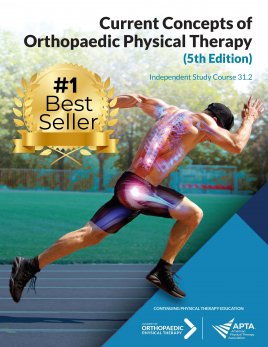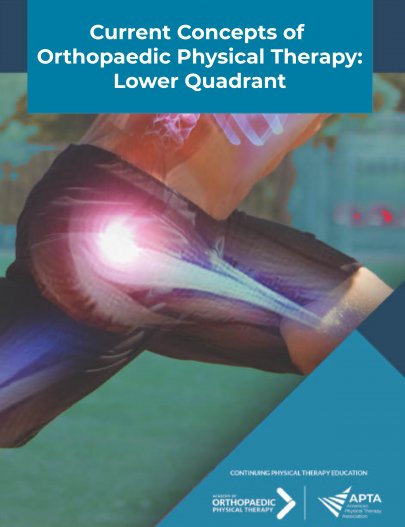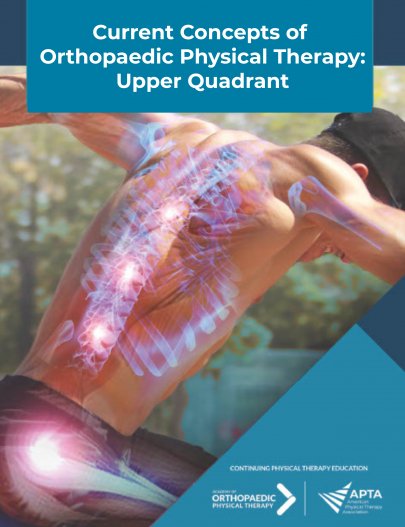
Current Concepts of Orthopaedic Physical Therapy, 5th Edition
| Online Only | Online + Hard Copy | |
|---|---|---|
| APTA Orthopedics Member | $330 | $395 |
| Non-APTA Orthopedics Member | $480 | $545 |
Related Courses
Get A Sneak Peek...
Course Description
In this 5th edition, each monograph offers a comprehensive, evidence-based review. The first monograph explores clinical reasoning and evidence usage in physical therapy. Following are 11 monographs, each focusing on a major body joint/region, from cervical spine to foot and ankle. They begin with anatomy and biomechanics, proceed with evidence-backed examination procedures for diagnosis and prognosis, and delve into musculoskeletal conditions and intervention strategies. Case scenarios prompt clinical reasoning and material integration. Authored by seasoned clinicians, this collection is a valuable resource for physical therapists treating musculoskeletal conditions.
Course Overview
Course Format: Online with an option to purchase the print version
Contact Hours: 96 contact hours
State Approval: AOPT courses are accepted in all states plus the District of Columbia, as allowed by the type of course requirements in state regulations. A small number of states require APTA to seek pre-approval of courses. The approval codes for these states can be found here. Always check with your State Licensing Board to confirm contact hours offered.
View Full State Approval InformationPlease take note...
If you purchased the digital copy and now want the printed copy, call APTA Orthopedics at (608)-788-3982 with credit card info. This course is 808 total pages.
Course Objectives
- Understand different types of clinical-reasoning strategies used during physical therapy management of individuals with musculoskeletal conditions.
- Conduct a thorough history/interview and perform a physical examination using evidence-based tests and measures for a variety of musculoskeletal conditions.
- Interpret the results of a musculoskeletal examination to develop an optimal plan of care.
- Detect red and yellow flags and understand their clinical implications.
- Apply research evidence to clinical decision-making related to the diagnosis, prognosis, and treatment of musculoskeletal conditions.
- Integrate knowledge of biological pain mechanisms (nociceptive, nociplastic [non-nociceptive], and neuropathic) as it relates to the physical therapy evaluation and treatment of musculoskeletal conditions.
- Understand how psychosocial factors can influence the pain experience in the context of musculoskeletal conditions.
- Discuss the importance of the therapeutic alliance and strategies to incorporate this alliance into clinical practice.
- Integrate common self-report and performance-based outcome measures as part of the assessment process.
- Discuss the relative role of diagnostic imaging and the clinical implications of positive/negative findings.
Topics and Authors
- Integration and Application of the Scientific Method, Evidence-based Practice, and Clinical Reasoning
Sean P. Riley, PT, DPT, ScD - The Cervical Spine: Evidence-Informed Physical Therapy Patient Management
Eric K. Robertson, PT, DPT, OCS, FAAOMPT; Mary K Derrick, PT, DPT, OCS, FAAOMPT - The Temporomandibular Joint: Evidence-Informed Physical Therapy Patient Management
Sally Ho, PT, DPT, MS, OCS; Kai-Yu Ho, PT, MSPT, PhD - The Thoracic Spine & Rib Cage: Evidence-Informed Physical Therapy Patient Management
Scott Burns, PT, DPT, OCS, FAAOMPT; Michael O’Hara, PT, DPT, OCS; William Egan, PT, DPT, OCS, FAAOMPT - The Shoulder: Evidence-Informed Physical Therapy Patient Management
Amee L. Seitz, PT, PhD, DPT, OCS; Heather Christain, PT, DPT, OCS, SCS; Adam Lutz, PT, DPT, PhD; Ellen Shanley, PT, PhD, OCS - The Elbow: Evidence-Informed Physical Therapy Patient Management
Mark Dutton, PT - The Wrist & Hand: Evidence-Informed Physical Therapy Patient Management
Mia Erickson, PT, EdD, CHT, ATC; Carol Waggy, PT, PhD, CHT - The Lumbar Spine: Evidence-Informed Physical Therapy Patient Management
Max Jordan, PT, DPT, PhD - The Pelvic Girdle: Evidence-Informed Physical Therapy Patient Management
Kathleen Chizewski Caulfield, PT, DPT, OCS, FAAOMPT; Leanna Blanchard, PT, DPT, CLT, OCS, FAAOMPT; Michael O’Hearn, PT, MHS, OCS, FAAOMPT; Carol A. Courtney, PT, PhD, ATC, FAAOMPT - The Hip: Evidence-Informed Physical Therapy Patient Management
Keelan Enseki, PT, MS, OCS, SCS; Dave Kohlrieser, PT, DPT, OCS, SCS; Allison Burfield, PT, DPT, OCS - The Knee: Evidence-Informed Physical Therapy Patient Management
Wm Gregory Seymour, PT, DPT, OCS, FAAOMPT; Scott Fenstermacher, PT, DPT, GCS, OCS; Jerry Smith, PT, DPT, OCS; Scott Dickenson, PT, DPT, SCS; Patrick Carter, PT, DPT; Tara Jo Manal, PT, DPT, OCS, SCS - The Foot and Ankle: Evidence-Informed Physical Therapy Patient Management
Lindsay A. Carroll, PT, DPT, OMPT; Stephen Paulseth, PT, MS, DPT, ATC; John J. Fraser, PT, DPT, PhD; RobRoy L. Martin, PT, PhD, CSCS
Customers Frequently Viewed
Raving Review
“Current Concepts of Orthopaedic Physical Therapy is a must read for every physical therapist who works in orthopedics.” Guy S from Wisconsin
Add To Cart
Which version of the course would you like to purchase?
Members Only
You need to be a member to buy this course.
Join today to enjoy exclusive deals and prices on all courses.
Join Now

